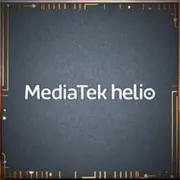MediaTek Helio P70

MediaTek Helio P70 in 2025: A Budget Chipset for Mid-Range Smartphones
April 2025
Introduction
The MediaTek Helio P70 is a processor that has established itself in the budget smartphone segment due to its balance of performance and energy efficiency. Although the chipset was introduced back in 2018, by 2025, it remains relevant in devices priced between $150 and $250. In this article, we will explore how the Helio P70 handles modern tasks, who it is suitable for, and what to consider when choosing a smartphone based on it.
Architecture and Process Technology: The Foundation of Performance
CPU: 8 Cores and Hybrid Architecture
The Helio P70 is built on a heterogeneous Big.Little architecture:
- 4 Cortex-A73 cores with a frequency of up to 2.1 GHz for resource-intensive tasks.
- 4 Cortex-A53 cores with a frequency of 2.0 GHz for background processes.
The total L2 cache size is 2 MB. This configuration ensures smooth multitasking, but by 2025, it falls short compared to modern chipsets that use Cortex-A75/A76 cores.
GPU: Mali-G72 MP3
The Mali-G72 MP3 graphics accelerator with three compute units supports resolutions up to Full HD+ (1080×2520) and a refresh rate of 60 Hz. It is compatible with Vulkan and OpenGL ES 3.2; however, it is not designed for demanding games like Genshin Impact at high settings.
12-Nanometer Process Technology
In 2025, a 12-nm process is considered outdated (modern chips use 6-7 nm technology). However, this helps reduce device costs and provides acceptable energy consumption, with a TDP of just 5 watts.
Performance in Real-World Tasks
Gaming
- Casual Gaming: Among Us, Clash Royale, Candy Crush – runs without lag.
- Medium Load: PUBG Mobile and Call of Duty: Mobile at medium settings (30-40 FPS).
- Intensive Titles: Genshin Impact and Honkai: Star Rail – can only be played on low settings with around 25 FPS.
Multimedia
- Supports 4K video at 30 fps (encoding and decoding).
- Smooth streaming of YouTube and Netflix in Full HD.
- Limitation: Lack of hardware decoding for AV1 – streaming services using this codec will tax the processor.
AI Applications
- The built-in APU (AI Processing Unit) speeds up scene recognition in the camera, portrait processing, and operation of voice assistants.
- Tasks such as automatic photo retouching in Google Photos or Adobe Lightroom are handled quickly, but neural network filters for real-time applications (e.g., video stylization) may experience lag.
Power Consumption and Heating
Thanks to its 5W TDP, smartphones using the Helio P70 rarely overheat even under prolonged strain. In mixed usage (social media, music, calls), a 5000 mAh battery lasts 1.5-2 days. However, active gaming reduces battery life to about 4-5 hours.
Integrated Modules: Connectivity and Navigation
- Modem: Supports 4G LTE Cat-12 (speeds up to 600 Mbps), but the lack of 5G is a significant drawback in 2025.
- Wi-Fi: Only Wi-Fi 5 (802.11ac), which limits speeds compared to Wi-Fi 6/6E.
- Bluetooth: Version 4.2 with BLE support—sufficient for connecting smartwatches and speakers, but not ideal for transmitting lossless audio.
- Navigation: GPS, GLONASS, Galileo—quick location determination even in dense urban areas.
Comparison with Competitors
MediaTek Helio G85 (2020)
- More powerful GPU Mali-G52 MC2—15-20% better performance in gaming.
- Supports displays with 90 Hz refresh rate.
- Cost of devices with G85 starts from $200.
Qualcomm Snapdragon 678 (2020)
- Adreno 612 vs. Mali-G72 MP3: Snapdragon excels in energy efficiency.
- Supports Wi-Fi 6 and Bluetooth 5.2.
- Devices are pricier—starting from $250.
Unisoc Tiger T610 (2021)
- Weaker in single-threaded tasks (Geekbench 6 Single Core score: 280).
- However, it is cheaper: devices start from $120.
Outcome: Helio P70 is suited for those looking for a proven platform with stable performance but are willing to compromise on the absence of 5G and Wi-Fi 6.
Usage Scenarios
1. Everyday Tasks
- Social media, messengers, browsing—all work quickly.
- Opening 5-7 apps simultaneously without reloading (with 4-6 GB of RAM).
2. Gaming
- Suitable for casual gamers or those willing to lower graphics settings.
3. Photography and Video
- Maximum camera support: up to 48 MP (single sensor) or 16+16 MP (dual camera).
- AI enhancement of photos: automatic white balance adjustment, noise reduction.
- 4K video recording is limited to 30 fps, with electronic stabilization performing moderately.
Pros and Cons of Helio P70
Advantages:
- Low device cost.
- Good battery life.
- Stable operation in basic scenarios.
Disadvantages:
- Lack of 5G and Wi-Fi 6.
- Outdated 12-nm process technology.
- Weak GPU for modern gaming.
Practical Tips for Choosing a Smartphone
1. RAM: At least 4 GB for comfortable multitasking.
2. Display: IPS or AMOLED with a 60 Hz refresh rate—higher makes little sense due to GPU limitations.
3. Battery: At least 5000 mAh to offset less advanced energy efficiency.
4. Camera: Look for models with optical image stabilization (OIS) to improve photo quality.
Examples of 2025 Devices:
- Realme C55 ($160): 6.5" IPS, 6/128 GB, 50 MP camera.
- Xiaomi Redmi 12 ($180): AMOLED, 5000 mAh, NFC.
Final Conclusion: Who is the Helio P70 Suitable For?
This processor is a good option for:
- Budget users who do not need 5G or top-tier gaming.
- Secondary devices: for example, a smartphone for study or work.
- Fans of long battery life.
The main benefits are low price (devices under $200), sufficient performance for basic tasks, and proven reliability. However, if you plan to use your smartphone for 3-4 years, it's better to consider chipsets that support 5G and have more modern GPUs.
The MediaTek Helio P70 demonstrates that even outdated chips can remain relevant in an era of rapid technological advancement—what matters is choosing the right use case.
Basic
4x 2 GHz – Cortex-A53
GPU Specifications
Connectivity
Memory Specifications
Miscellaneous
Benchmarks
Compared to Other SoC
Share in social media
Or Link To Us
<a href="https://cputronic.com/soc/mediatek-helio-p70" target="_blank">MediaTek Helio P70</a>